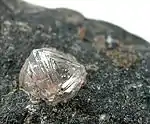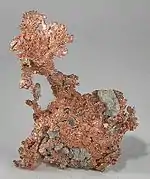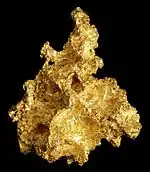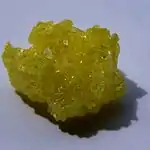Native element mineral
Native element minerals are those elements that occur in nature in uncombined form with a distinct mineral structure. The elemental class includes metals and intermetallic elements (naturally occurring alloys), semi-metals and non-metals. The Nickel–Strunz classification system also includes the naturally occurring phosphides, silicides, nitrides and carbides and arsenides.

Diamond (native carbon)
Elements
The following elements occur as native element minerals or alloys:[1]
Nickel–Strunz Classification -01- Native elements
This list uses the Classification of Nickel–Strunz (mindat.org, 10 ed, pending publication).
- Abbreviations
- "*" – discredited (IMA/CNMNC status).
- "?" – questionable/doubtful (IMA/CNMNC status).
- "REE" – Rare-earth element (Sc, Y, La, Ce, Pr, Nd, Pm, Sm, Eu, Gd, Tb, Dy, Ho, Er, Tm, Yb, Lu)
- "PGE" – Platinum-group element (Ru, Rh, Pd, Os, Ir, Pt)
- 03.C Aluminofluorides, 06 Borates, 08 Vanadates (04.H V[5,6] Vanadates), 09 Silicates:
- Nickel–Strunz code scheme
- NN.XY.##x:
- NN: Nickel–Strunz mineral class number
- X: Nickel–Strunz mineral division letter
- Y: Nickel–Strunz mineral family letter
- ##x: Nickel–Strunz mineral/group number, x add-on letter
Class: native elements
- 01.A Metals and Intermetallic Alloys
- 01.AA Copper-cupalite family: 05 Native copper, 05 Lead, 05 Native gold, 05 Native silver, 05 Nickel, 05 Aluminium; 10a Auricupride, 10b Tetra-auricupride; 15 Novodneprite, 15 Khatyrkite, 15 Anyuiite; 20 Cupalite, 25 Hunchunite
- 01.AB Zinc-brass family (Cu-Zn alloys): 05 Cadmium, 05 Zinc, 05 Titanium*, 05 Rhenium*; 10a Brass*, 10a Zhanghengite, 10b Danbaite, 10b Tongxinite*
- 01.AC Indium-tin family: 05 Indium, 10 Tin; 15 Yuanjiangite, 15 Sorosite
- 01.AD Mercury-amalgam family: 00 Amalgam*, 05 Mercury; 10 Belendorffite, 10 Kolymite; 15a Paraschachnerite, 15a Schachnerite, 15b Luanheite, 15c Eugenite, 15d Moschellandsbergite; 20a Weishanite, 20b Goldamalgam*; 25 Potarite, 30 Leadamalgam
- 01.AE Iron-chromium family: 05 Kamacite? (Iron var.), 05 Iron, 05 Chromium; 10 Antitaenite*, 10 Taenite, 10 Tetrataenite; 15 Chromferide, 15 Wairauite, 15 Ferchromide; 20 Awaruite, 25 Jedwabite
- 01.AF Platinum-group elements: 05 Osmium, 05 Rutheniridosmine, 05 Ruthenium; 10 Palladium, 10 Iridium, 10 Rhodium, 10 Platinum
- 01.AG PGE-metal alloys: 05 Garutiite, 05 Hexaferrum; 10 Atokite, 10 Zvyagintsevite, 10 Rustenburgite; 15 Taimyrite, 15 Tatyanaite; 20 Paolovite; 25 Plumbopalladinite, 25 Stannopalladinite; 30 Cabriite; 35 Chengdeite, 35 Isoferroplatinum; 40 Ferronickelplatinum, 40 Tetraferroplatinum, 40 Tulameenite; 45 Hongshiite*, 45 Skaergaardite; 50 Yixunite, 55 Damiaoite, 60 Niggliite, 65 Bortnikovite, 70 Nielsenite
- 01.B Metallic Carbides, Silicides, Nitrides and Phosphides
- 01.BA Carbides: 05 Cohenite; 10 Isovite, 10 Haxonite; 15 Tongbaite; 20 Khamrabaevite, 20 Niobocarbide, 20 Tantalcarbide; 25 Qusongite, 30 Yarlongite
- 01.BB Silicides: Zangboite; 05 Mavlyanovite, 05 Suessite; 10 Perryite, 15 Fersilicite*, 20 Ferdisilicite*, 25 Luobusaite, 30 Gupeiite, 35 Hapkeite, 40 Xifengite
- 01.BC Nitrides: 05 Roaldite, 10 Siderazot, 15 Carlsbergite, 15 Osbornite
- 01.BD Phosphides: 05 Schreibersite, 05 Nickelphosphide; 10 Barringerite, 10 Monipite; 15 Allabogdanite, 15 Florenskyite, 15 Andreyivanovite; 20 Melliniite
- 01.C Metalloids and Nonmetals
- 01.CA Arsenic group elements: 05 Bismuth, 05 Antimony, 05 Arsenic, 05 Stibarsen; 10 Arsenolamprite, 10 Pararsenolamprite; 15 Paradocrasite
- 01.CB Carbon-silicon family: 05a Graphite, 05b Chaoite, 05c Fullerite; 10a Diamond, 10b Lonsdaleite, 15 Silicon
- 01.CC Sulfur-selenium-iodine: 05 Sulfur, 05 Rosickyite; 10 Tellurium, 10 Selenium
- 01.D Nonmetallic Carbides and Nitrides
- 01.DA Nonmetallic carbides: 05 Moissanite
- 01.DB Nonmetallic nitrides: 05 Nierite, 10 Sinoite
- 01.X Unclassified Strunz Elements (Metals and intermetallic alloys; metalloids and nonmetals; carbides, silicides, nitrides, phosphides)
- 01.XX Unknown: 00 Hexamolybdenum, 00 Tantalum*, 00 Brownleeite
See also
References
- "IMA-CNMNC List of Minerals" (PDF). Archived from the original (PDF) on 2016-04-23. Retrieved 2016-05-24.
- Stuart J. Mills; Frédéric Hatert; Ernest H. Nickel & Giovanni Ferraris (2009). "The standardisation of mineral group hierarchies: application to recent nomenclature proposals" (PDF). Eur. J. Mineral. 21 (5): 1073–1080. doi:10.1127/0935-1221/2009/0021-1994.
- Nickel, Ernest H.; Nichols, Monte C. (March 2009). "IMA-CNMNC List of Mineral Names" (PDF). IMA-CNMNC.
- Ferraiolo, Jim. "Nickel–Strunz (Version 10) Classification System". webmineral.com.
- Mineralsystematik nach Strunz 9. Auflage von 2001 (aktuell)
- Hr. Dr. Udo Neumann der Uni-Tuebingen (Systematik der Minerale)
This article is issued from Wikipedia. The text is licensed under Creative Commons - Attribution - Sharealike. Additional terms may apply for the media files.



